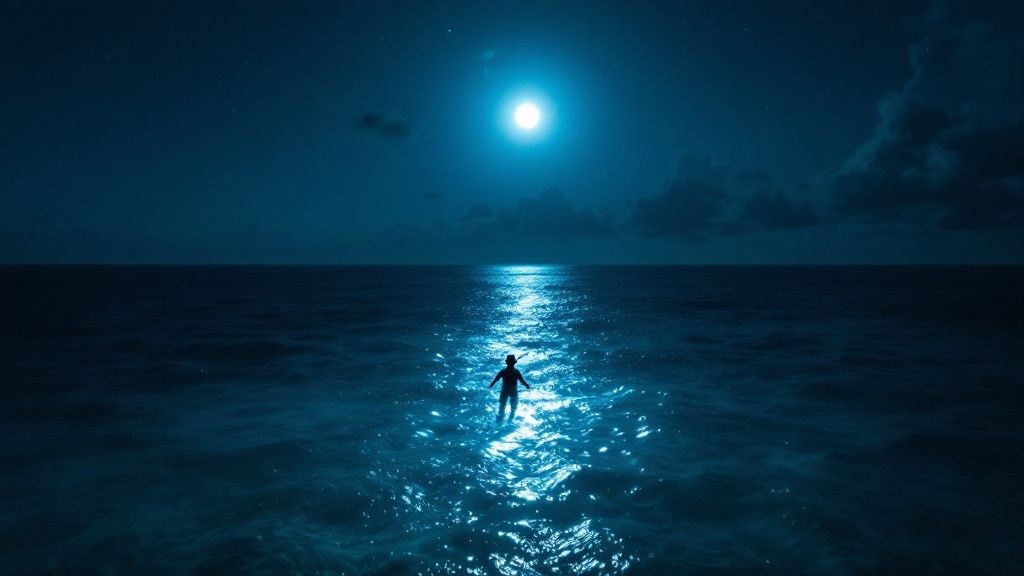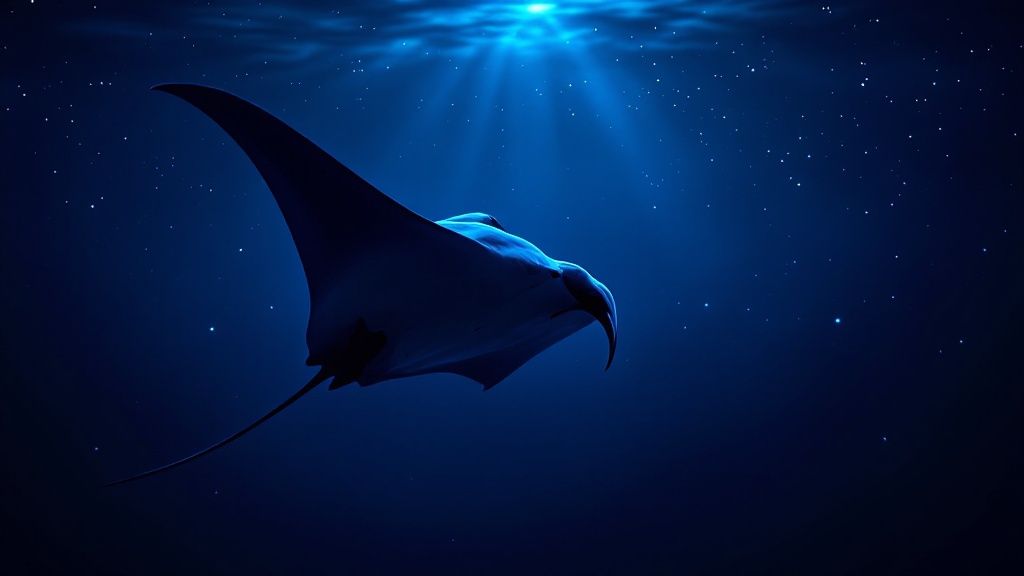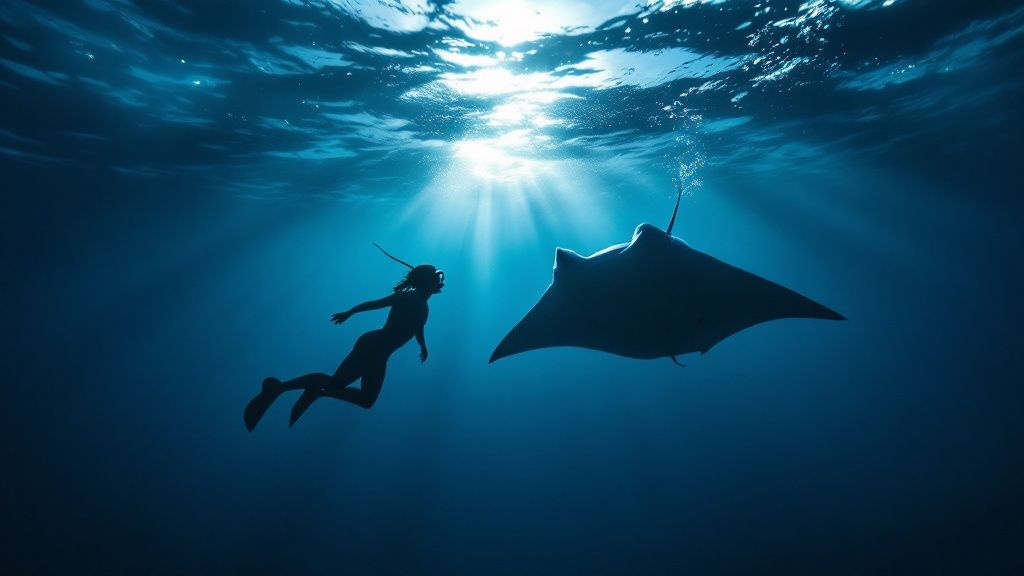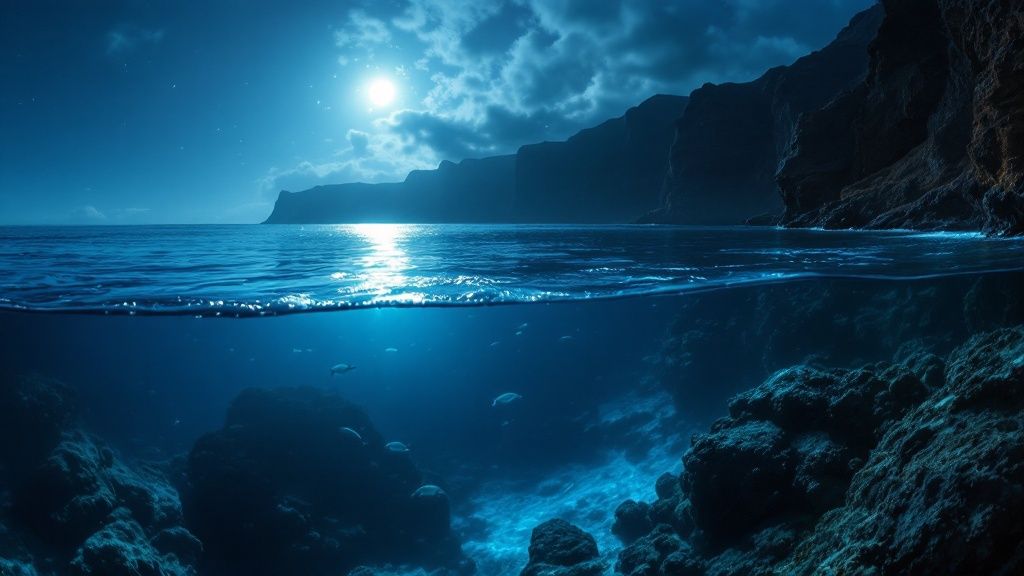Manta Ray Night Snorkel Big Island Trip

The Magic of Manta Ray Night Snorkel Big Island
Few experiences can compare to the magic of a manta ray night snorkel off the Big Island of Hawaii. Imagine floating in the dark ocean, the only sound the gentle rhythm of waves against your board. Suddenly, enormous manta rays emerge from the depths, their wingspans reaching an incredible 14 feet. Illuminated by underwater lights, these graceful creatures create an unforgettable spectacle. It's a chance to connect with these gentle giants of the ocean in a truly unique way.
This incredible experience is made possible by the fascinating interaction between light, plankton, and the manta rays' feeding habits. Plankton, the microscopic organisms at the base of the ocean's food chain, are naturally drawn to light. Tour operators use underwater lights to attract the plankton, creating an irresistible feast for the manta rays.
As the mantas feed, they perform an underwater ballet of graceful movements, including acrobatic backflips and barrel rolls. Often mistaken for stingrays, these gentle giants are actually filter feeders, posing no threat to humans. Their diet consists solely of plankton and small crustaceans. This nightly feeding ritual is a captivating sight for snorkelers.
What Makes Big Island Manta Ray Snorkeling So Special?
The reliability of manta ray sightings on the Big Island contributes to the magic. This location is renowned worldwide for its high encounter rates. Operators like Jack's Diving Locker report an average 85-90% success rate for manta ray sightings during night snorkel tours. This high success rate is due to the manta rays' natural feeding patterns, drawing them to the plankton that gathers near the underwater lights.
Several factors influence sighting rates. Moon phases affect ambient light and plankton visibility. Seasonal plankton blooms increase manta ray activity. Ocean conditions, like water clarity and current strength, also play a role. The typically clear, warm waters around the Big Island provide excellent visibility, making the experience even more memorable. However, because manta rays are wild animals, sightings are never guaranteed, and their appearances are always subject to natural variations. For more detailed information, check out the Jack's Diving Locker Manta Ray Report.
Choosing the Right Tour Operator
With the growing popularity of manta ray night snorkeling, selecting the right tour operator is crucial. Several reputable companies offer this experience, including Kona Honu Divers, Manta Ray Night Snorkel Hawaii, Kona Snorkel Trips, and Captain Cook Snorkeling Tours. Each company offers a unique approach and various options. Prioritize operators committed to sustainable practices and small group sizes for a respectful and impactful experience for both you and the manta rays.
Prime Locations: Where Manta Magic Happens

Picking the perfect spot for your Big Island manta ray night snorkel can truly make all the difference. The Kona coast boasts several amazing locations, each with its own distinct personality. Two favorites are Makako Bay, nicknamed "Manta Heaven," and Keauhou Bay, affectionately known as "Manta Village."
Makako Bay earns its heavenly reputation with consistently clear water and reliable manta ray sightings. The relatively calm bottom makes it a great choice for beginners. Plus, the excellent visibility offers stunning views of these graceful creatures. These calm conditions make for regular, predictable encounters, solidifying Makako Bay's place in the hearts of manta ray lovers.
Keauhou Bay provides a more energetic experience. Stronger currents, while sometimes stirring up sediment, bring a feast of plankton, the manta rays' main food source. This often leads to more active feeding, showcasing the dramatic barrel rolls Keauhou Bay is famous for.
The growing popularity of manta ray night snorkeling on the Big Island has fueled a thriving ecotourism scene. By 2015, over 42 commercial tour operators offered manta ray night snorkel and dive trips. On busy evenings, you might find 28 boats and 170 people in the water, highlighting the significant economic impact of these gentle giants. This emphasizes the importance of responsible and sustainable tourism to preserve the manta rays and their habitat. Learn more about this fascinating relationship here. You can also explore our site activity for more information.
The following table provides a helpful overview of different locations for your manta ray adventure.
Comparison of Big Island Manta Ray Snorkel Locations
This table compares the key differences between the main manta ray viewing locations on the Big Island to help visitors choose the best spot for their adventure.
| Location | Average Visibility | Current Strength | Crowd Size | Best Time to Visit | Unique Features |
|---|---|---|---|---|---|
| Makako Bay (Manta Heaven) | High | Low | High | Year-round | Calm waters, ideal for beginners |
| Keauhou Bay (Manta Village) | Moderate | Moderate to High | High | Year-round | More active feeding behavior, barrel rolls |
| Kohala Coast (Kawaihae Harbor) | High | Varies | Low | Year-round | More intimate experience, less frequent sightings |
As you can see, each location offers a unique experience. Consider your experience level and desired interaction when making your choice.
Exploring Emerging Viewing Spots
Looking for a more intimate encounter? Consider exploring some of the lesser-known viewing areas. These less-crowded spots can offer a closer connection with the manta rays.
Some operators, for example, offer tours off the Kohala coast near Kawaihae harbor. While manta ray sightings might be less frequent, the chance of being the only group in the water is a significant draw for those seeking a smaller, more private experience.
Choosing the right location comes down to understanding the conditions and what you want from your experience. Water currents, bottom topography, and the presence of other snorkelers all play a role. Researching these factors will help you pick the perfect place to witness the magic of manta rays on the Big Island.
Selecting Your Perfect Manta Ray Tour Partner

Planning a manta ray night snorkel on the Big Island? Not all tours are created equal. Picking the right operator can make a huge difference in your experience and the well-being of these gentle giants.
It's important to look beyond the glossy brochures and consider the details. An operator’s experience, their commitment to sustainable tourism, and even the quality of their equipment can significantly impact your adventure.
Key Factors to Consider When Choosing a Tour Operator
Don't just book the cheapest tour you find. Take the time to research each operator's offerings and ask questions. Inquire about group sizes: smaller groups often mean a more personalized experience with less disturbance to the manta rays.
Crucially, look for operators dedicated to eco-friendly practices. Responsible operators prioritize the health of the manta rays and their environment. They should adhere to established guidelines, ensuring respectful interactions and minimal impact on the marine ecosystem.
- Guide Expertise: A knowledgeable guide can enrich your experience by sharing insights into manta ray behavior and the local marine life.
- Group Size: Smaller, intimate groups often provide better viewing opportunities and a more personalized experience.
- Equipment Quality: Reliable snorkel gear and a comfortable vessel are essential for a safe and enjoyable trip.
- Commitment to Sustainability: Choose operators who demonstrate a genuine commitment to protecting these amazing creatures and their habitat.
Decoding Online Reviews and Testimonials
Reading online reviews can provide a glimpse into other people’s experiences. Focus on reviews that offer specific details about the guide’s knowledge, the operator’s sustainability efforts, and the overall quality of the tour. These details are often more insightful than vague, generic praise. For more information, visit our site.
Recommended Manta Ray Tour Operators
To get you started, here are a few reputable operators offering manta ray night snorkel tours on the Big Island:
To help you make an informed decision, check out this comparison table:
Recommended Manta Ray Night Snorkel Tour Operators
This table presents key information about top-rated tour operators to help visitors make informed choices based on their preferences and needs.
| Tour Operator | Price Range | Group Size | Departure Location | Duration | Special Features | Best For |
|---|---|---|---|---|---|---|
| Kona Honu Divers | $$ | Varies | Kona | ~2 hours | Experienced guides, focus on safety | Families, beginners |
| Manta Ray Night Snorkel Hawaii | $$ | Small | Kona | ~2 hours | Personalized experience, underwater photography | Small groups, photographers |
| Kona Snorkel Trips | $$ | Varies | Kona | ~2 hours | Knowledgeable guides, focus on education | Nature enthusiasts |
| Captain Cook Snorkeling Tours | $$ | Varies | Keauhou Bay | ~2.5 hours | Scenic bay location, historical context | History buffs, scenic views |
Each operator offers unique aspects, catering to different needs and preferences. Doing some research beforehand will help you find the best fit for an unforgettable manta ray encounter. Choose a partner who values both your enjoyment and the well-being of these magnificent creatures.
Your Manta Ray Adventure: From Sunset to Unforgettable

A manta ray night snorkel off the Big Island is an experience unlike any other. As the sun sets, casting vibrant hues of orange and pink across the sky, your boat journey to the snorkel site begins. The excitement mounts as you leave the harbor, the lights of Kona receding into the distance.
Arriving at the snorkel spot, often called "Manta Village" or "Manta Heaven," your guide provides a comprehensive safety briefing. This includes crucial information on using the snorkel gear and interacting respectfully with the manta rays. You'll be pleasantly surprised by the warm Hawaiian waters, even after sunset, making your wetsuit or flotation device incredibly comfortable.
Once in the water, you'll hold onto a specialized light board. The light attracts plankton, the manta rays' main food source. This is where the real magic unfolds. As your eyes adapt to the darkness, enormous shadows begin to emerge below. These are the manta rays, drawn to the plankton illuminated by the boards.
An Up-Close Encounter
This Big Island manta ray night snorkel isn't just a quick glimpse of these gentle giants. It's a truly immersive experience. Mantas, with wingspans often exceeding ten feet, execute graceful loops and barrel rolls just beneath you.
You'll observe their unique feeding habits up close, a mesmerizing ballet of effortless movement that's both exhilarating and deeply calming.
Contributing to Research
This activity also contributes to valuable scientific research. Manta ray night snorkeling provides essential observational data, crucial for understanding these magnificent creatures. Researchers use data gathered from these popular snorkel sites to study manta ray behavior and population dynamics. Learn more about manta ray statistics here. You might also be interested in our sitemap.
A Sensory Symphony
The experience engages all your senses. The gentle rhythm of the ocean, the soft glow of the lights, the sound of your own breath through the snorkel, and the awe-inspiring sight of these creatures gliding through the dark water combine to create a truly unforgettable experience. The boat ride back to shore, under a blanket of stars, provides the perfect culmination to this adventure, leaving you with cherished memories of connecting with these gentle giants in their natural habitat.
Choosing a reputable tour operator enhances this already incredible experience. Some excellent options include Kona Honu Divers, Manta Ray Night Snorkel Hawaii, Kona Snorkel Trips, or Captain Cook Snorkeling Tours.
Insider Tips for an Extraordinary Manta Encounter

Want to make your Big Island manta ray night snorkel truly special? These insider tips, gleaned from seasoned guides and marine biologists, will help you take your experience from simply memorable to absolutely extraordinary. Get ready to enhance your interaction with these gentle giants and fully enjoy this amazing encounter.
Positioning for the Perfect View
For the best manta ray viewing, proper positioning is essential. Hold onto the floatation device provided, staying as still and calm as possible. This conserves your energy and minimizes disruptions to the manta rays. Be a respectful observer, allowing these incredible creatures to gracefully move around you. For more snorkel tips, check out this helpful resource: How to master your snorkel experience.
Encouraging Manta Ray Interaction
While touching a manta ray is never permitted, you can subtly encourage them to come closer. Shine a steady light downwards. This attracts plankton, their primary food source. Imagine setting up a delicious banquet, drawing these gentle giants closer for a feast just below you.
Staying Warm and Comfortable
Hawaiian waters can feel quite cool after the sun sets. Staying warm is important so you can fully appreciate the magic of the manta ray experience. A wetsuit, even during summer, will help maintain a comfortable body temperature throughout your snorkel. Think of it as your cozy underwater companion, letting you fully enjoy every moment.
Combating Seasickness and Mask Fog
Seasickness or a foggy mask can quickly ruin your enjoyment. Be proactive and address these potential issues beforehand. Take seasickness medication before your Big Island manta ray night snorkel adventure. Also, pre-treat your mask with defogger or a drop of baby shampoo to keep your view crystal clear. These simple precautions will ensure you don’t miss a thing.
Capturing the Magic: Photography Tips
Looking to capture amazing photos of these graceful creatures? A GoPro or similar underwater camera with red filters for night photography works well. Keep your camera close and avoid using flash, as it can startle the manta rays. Prioritize respectful observation and minimize disruptions. Remember, the well-being of these animals comes first.
Moon Phases and Seasonal Variations
When planning your Big Island manta ray night snorkel trip, consider the moon phases and seasonal changes. A darker, new moon night offers better contrast, making the manta rays appear even more striking against the illuminated plankton. While mantas are present year-round, certain seasons offer calmer waters and improved visibility.
By following these insider tips, you can forge a deeper connection with these magnificent animals and create an unforgettable manta ray night snorkel experience on the Big Island.
Protecting The Magic: The Conservation Connection
A manta ray night snorkel on the Big Island is an unforgettable experience. But it's more than just a magical moment; it’s a vital part of a larger conservation effort. This special ecosystem thrives because of a careful balance between tourism and environmental protection, making it a global example of sustainable wildlife interaction.
This delicate harmony has led to crucial safeguards. Responsible tourism, like the practices once encouraged by the Green List (discontinued in 2023), is essential. These practices minimize disruption to the manta rays and their environment, highlighting respectful observation. You can learn more about these practices in our article about site details.
The Life Cycle of Gentle Giants
Learning about the manta ray life cycle underscores the importance of conservation. Manta rays reproduce slowly, with females birthing only one pup every few years. This makes them especially susceptible to environmental changes and human interference. Preserving their feeding grounds and minimizing disturbances is key to maintaining a healthy population.
Threats to Manta Rays
Manta rays face many dangers worldwide, including accidental capture in fishing nets and habitat loss. The demand for their gill plates in some forms of traditional medicine also creates a serious problem. While hunting manta rays is illegal in Hawaiian waters, keeping their plankton-rich feeding areas healthy is vital for their long-term survival.
The Role of Organizations Like Manta Ray Advocates Hawaii
Organizations such as Manta Ray Advocates Hawaii are instrumental in monitoring and identifying individual manta rays. Their efforts help scientists learn about population changes, migration routes, and individual behaviors. Naming many of the local manta rays allows researchers and guides to recognize familiar individuals and build a deeper connection with these incredible creatures.
Citizen Science: Your Contribution to Conservation
A manta ray night snorkel gives you the opportunity to become a citizen scientist. By respectfully observing and sharing your experiences, you provide important information that helps ongoing conservation work. This participatory approach builds a sense of responsibility and strengthens our relationship with the ocean. This unique form of ecotourism directly funds the research and protection efforts that will allow future generations to experience the wonder of manta rays.
Book Your Unforgettable Manta Ray Adventure Today!
Ready to witness the magic of manta rays while supporting their conservation? Book your tour with Kona Snorkel Trips today! We are dedicated to providing exceptional, sustainable tours that focus on both your enjoyment and the welfare of these magnificent animals. Join us for an incredible adventure in the heart of “Manta Heaven.”
